Sir John Monash, Personal Files Book 15, 1 April - 10 May 1917, Part 11
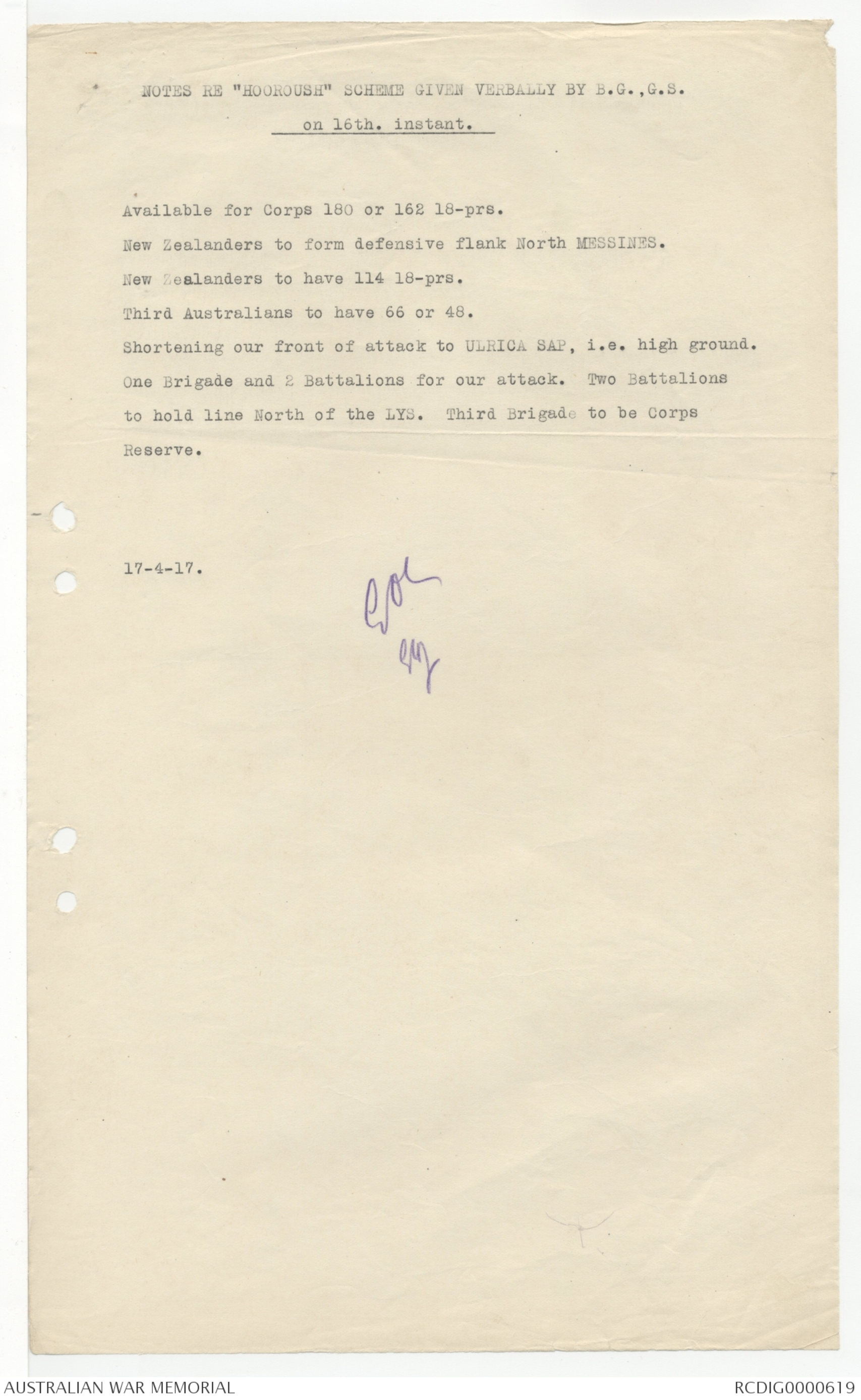
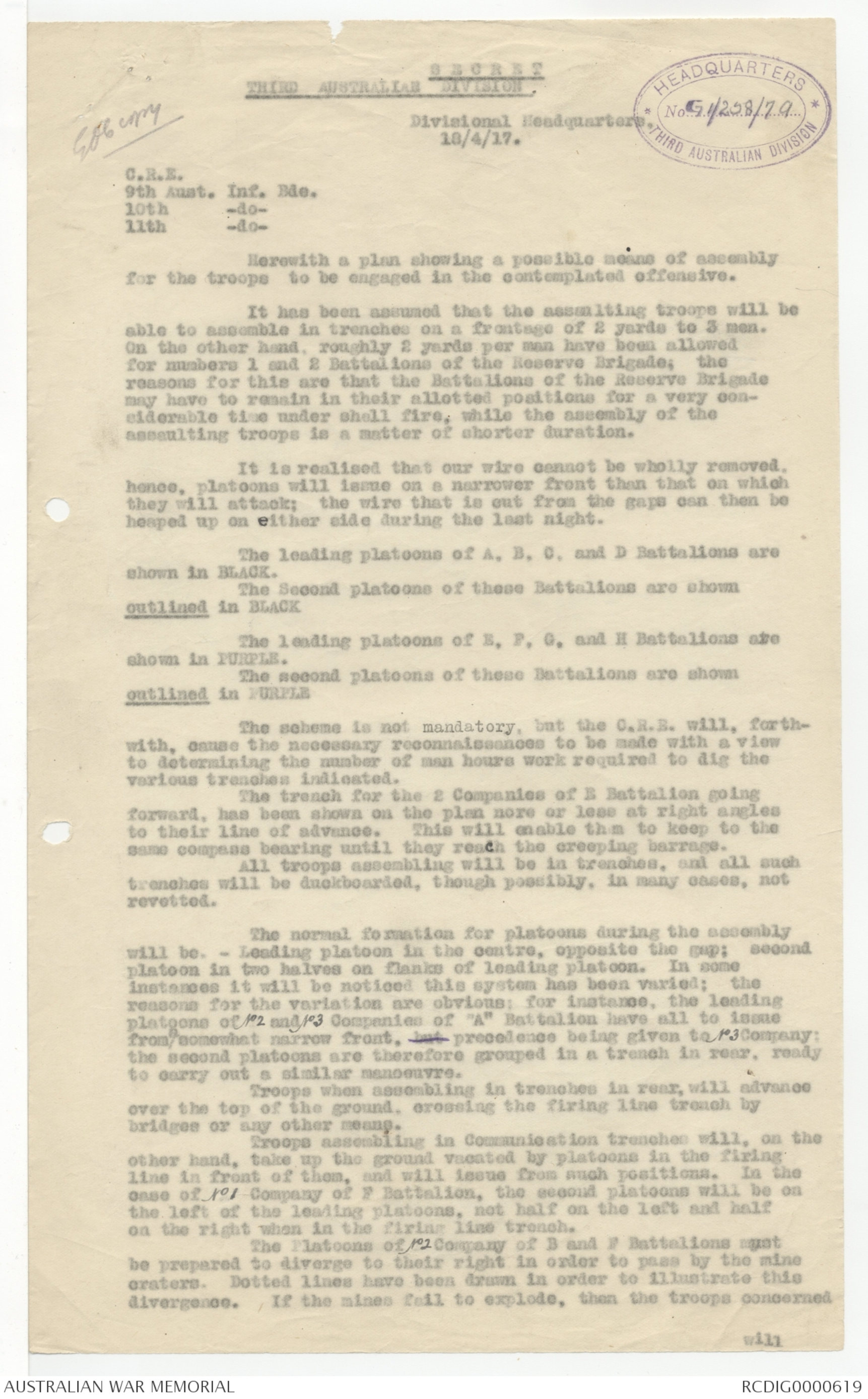
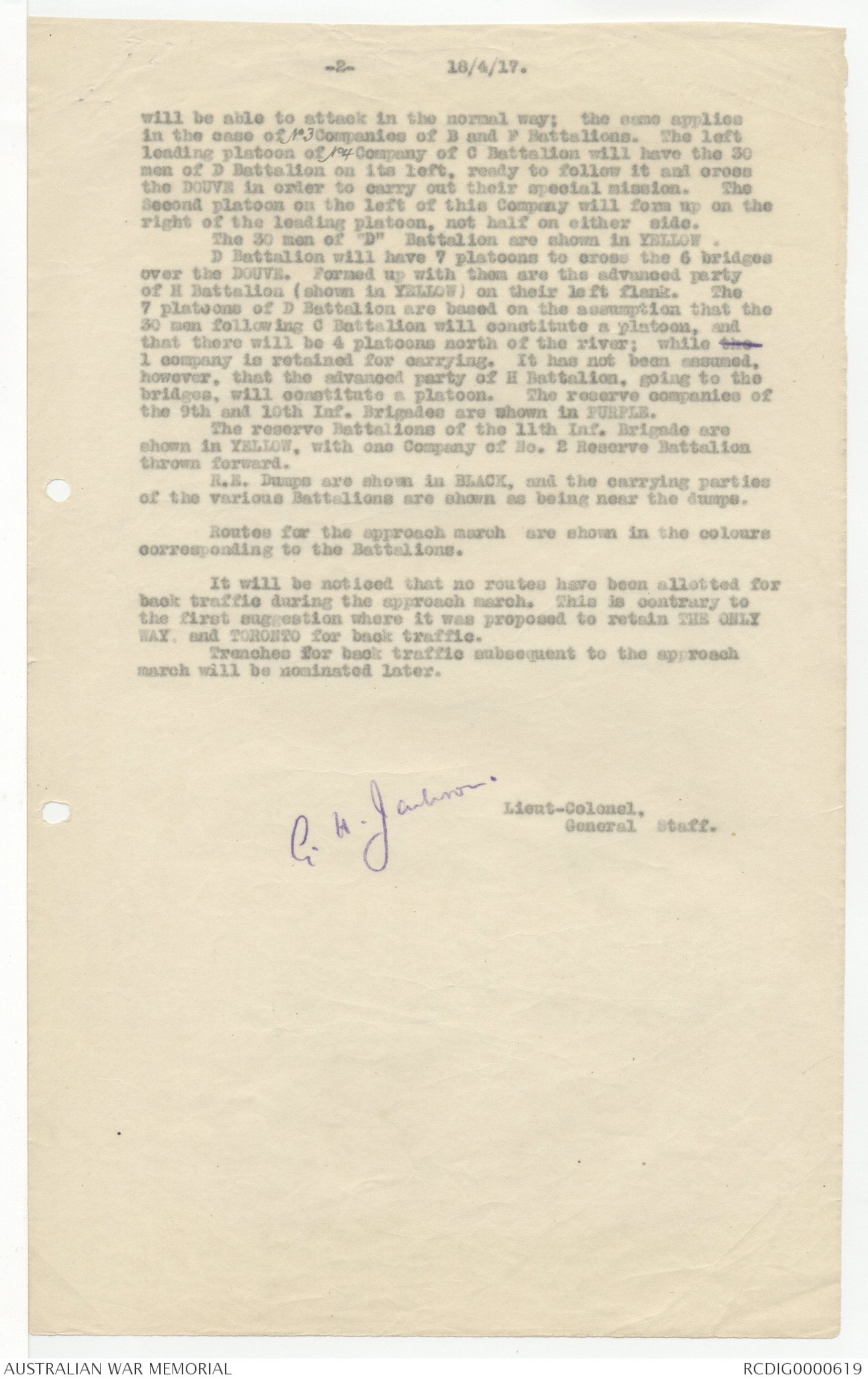
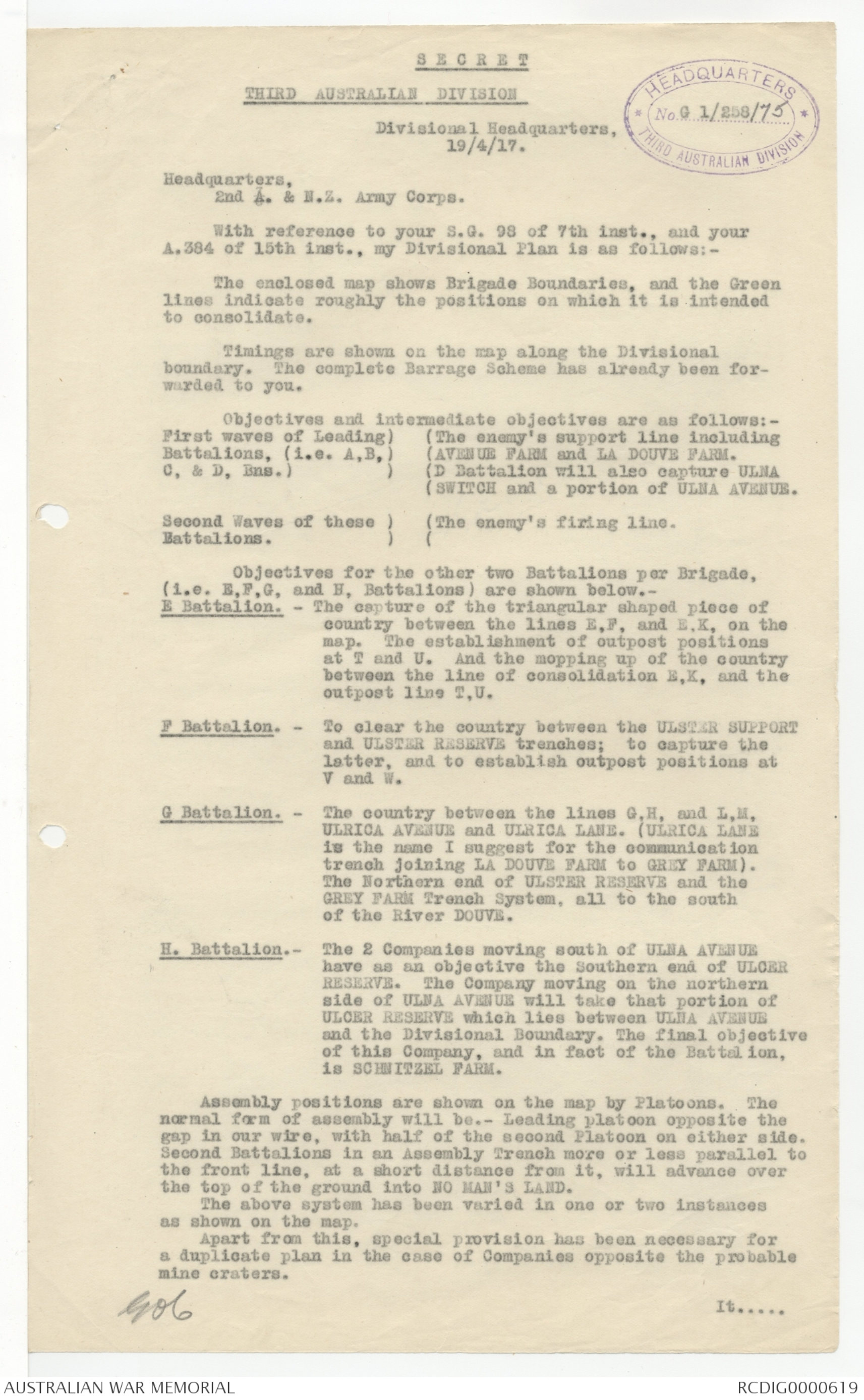
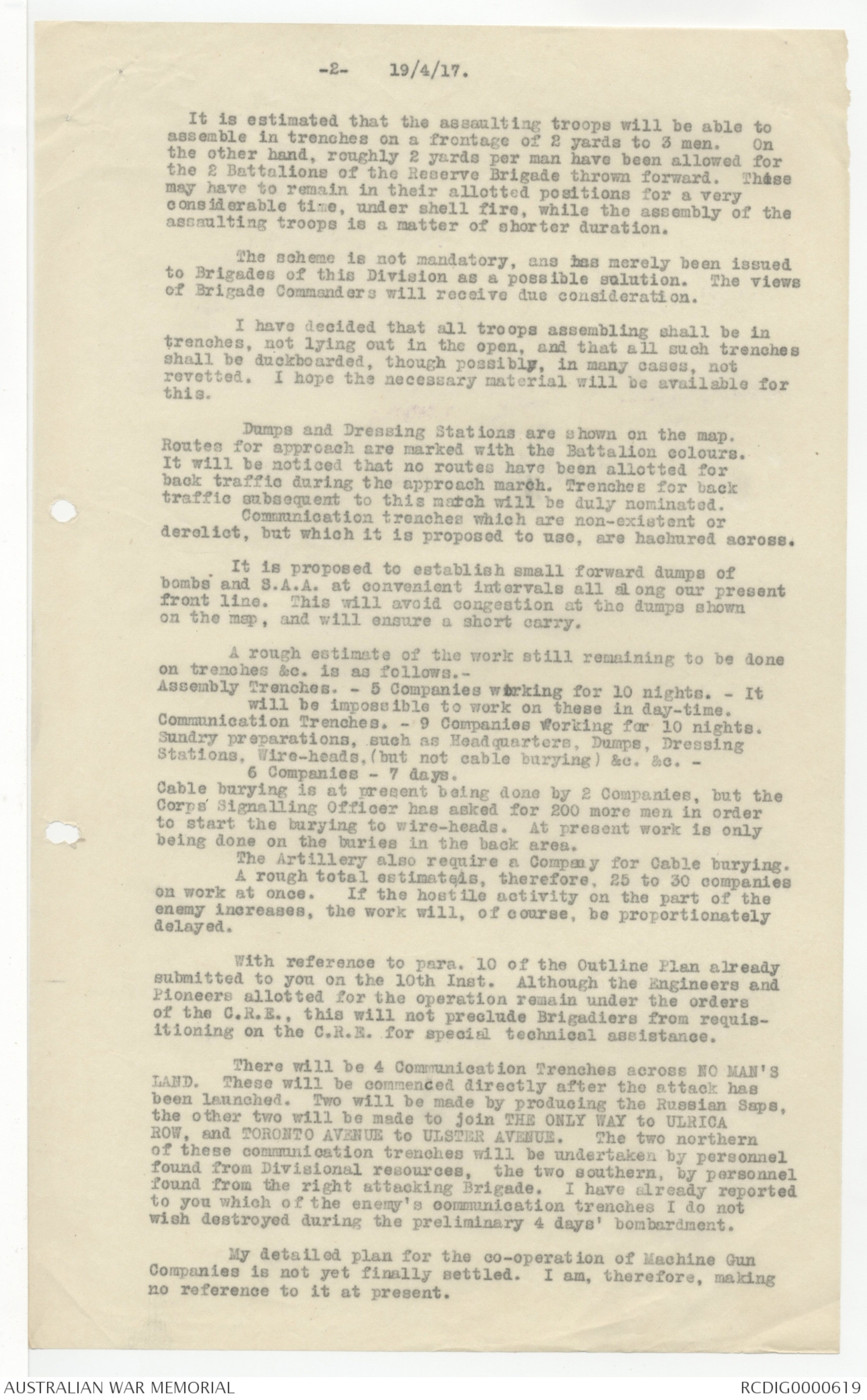
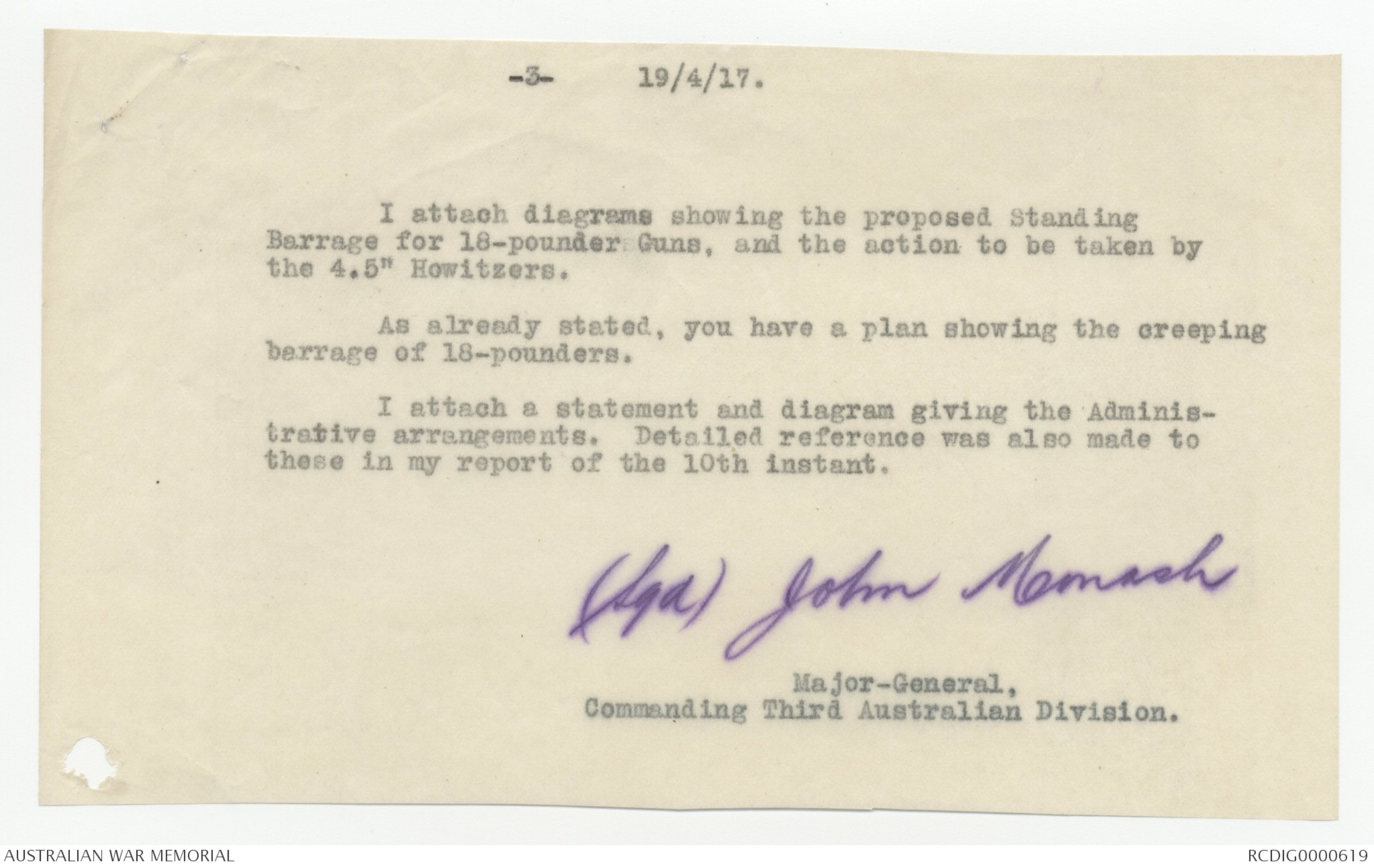
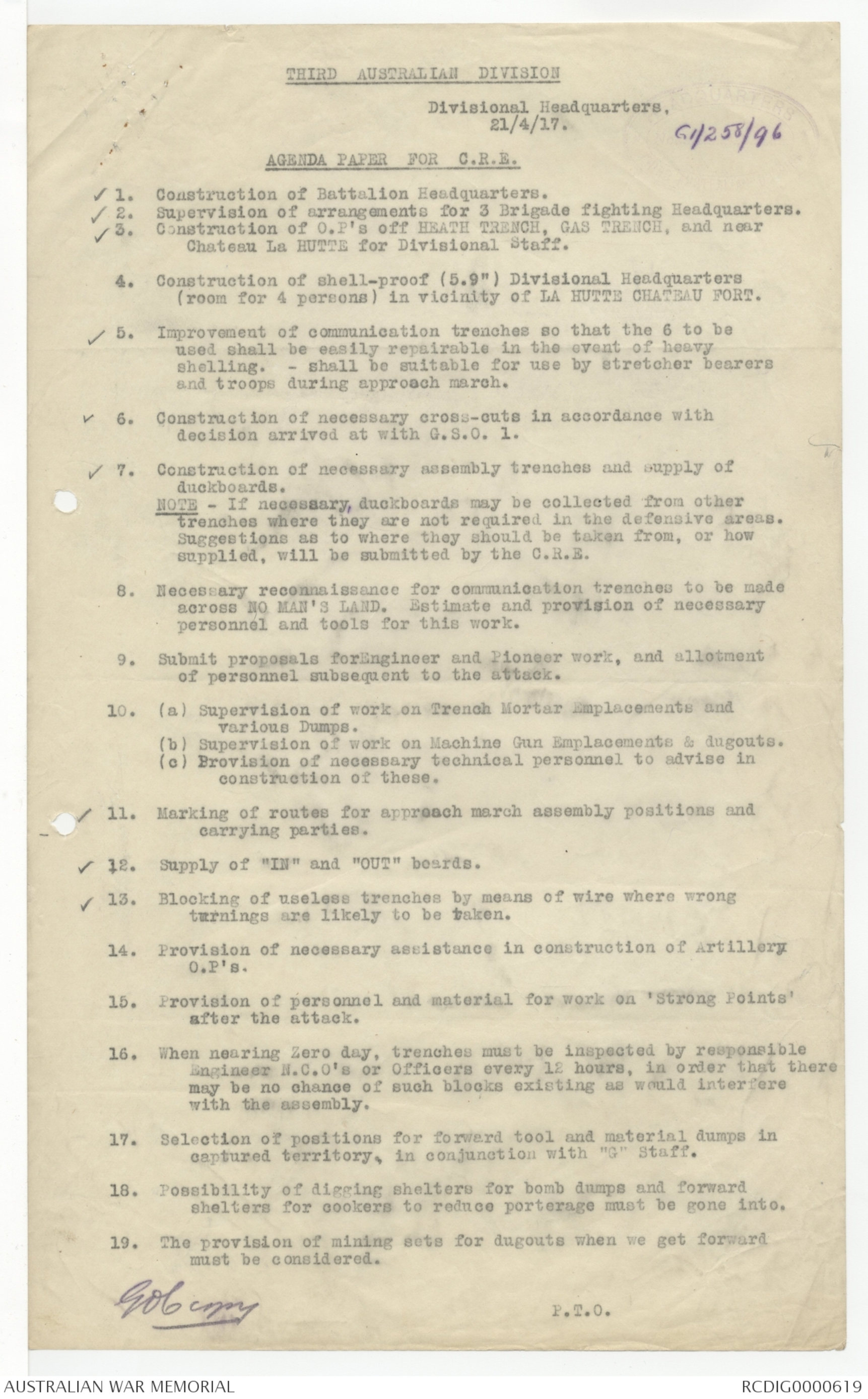
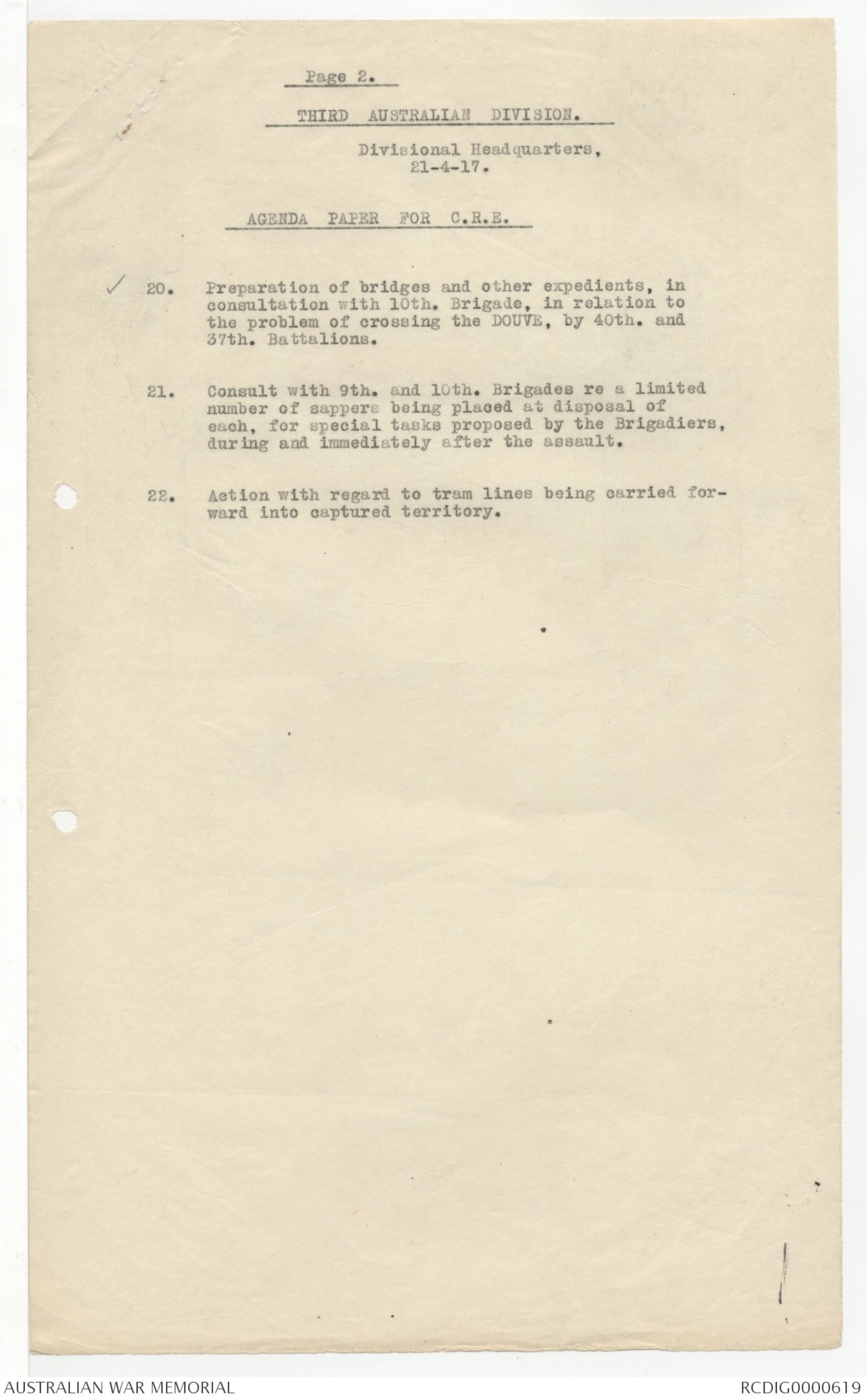
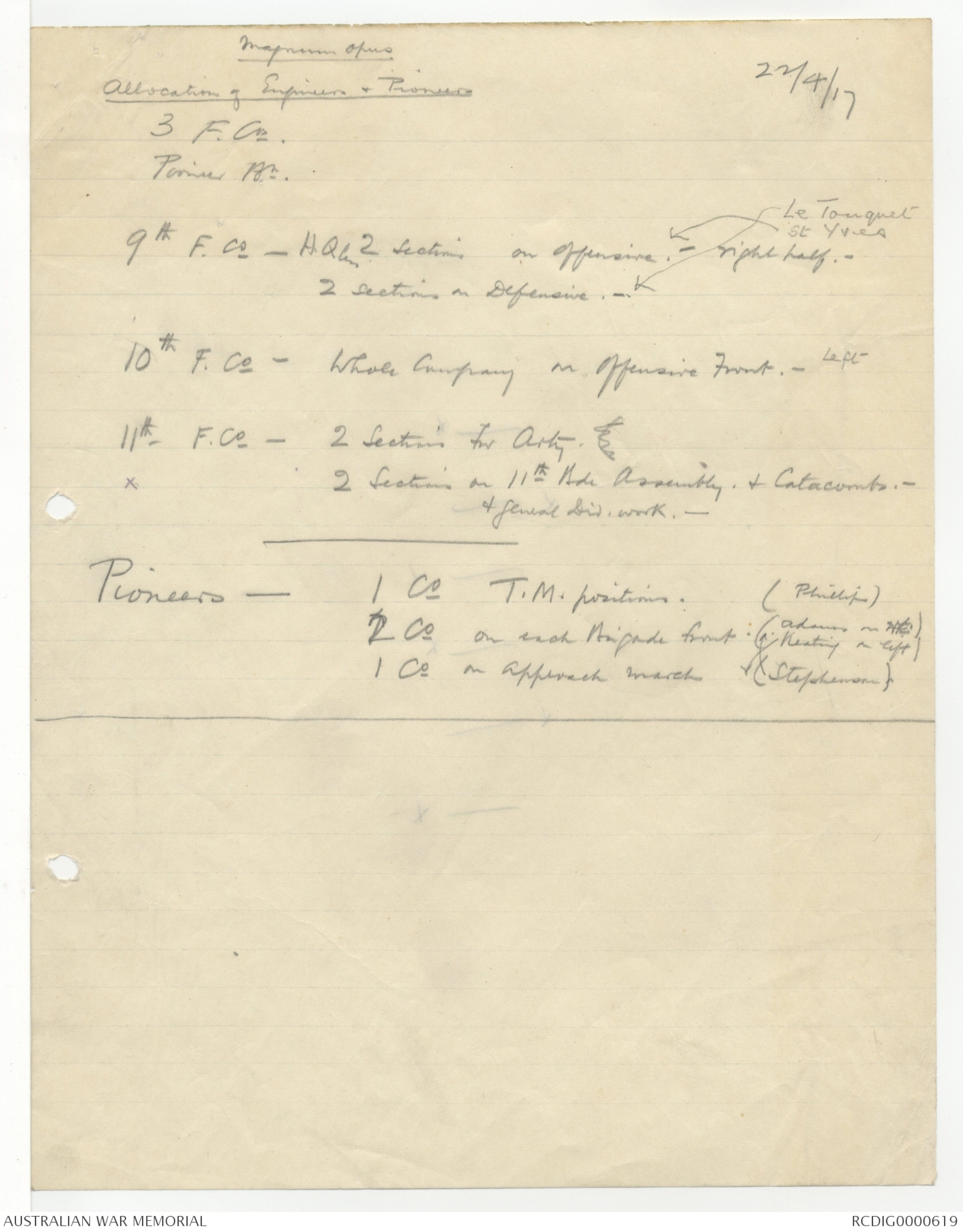
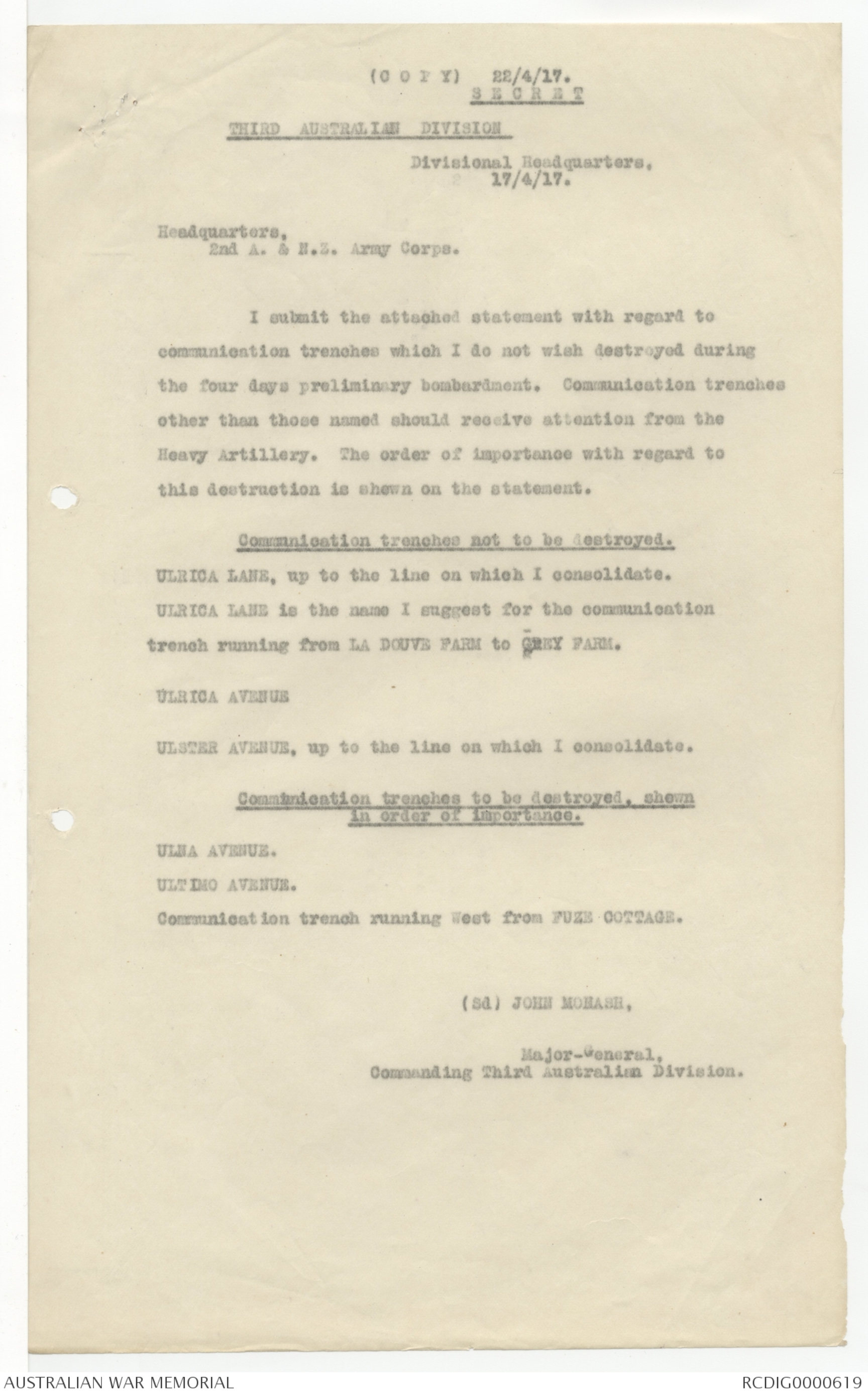
NOTES RE "HOOROUSH" SCHEME GIVEN VERBALLY BY B.G.,G.S.
on 16th. instant.
Available for Corps 180 or 162 18-prs.
New Zealanders to form defensive flank North MESSINES.
New Zealanders to have 114 18-prs.
Third Australians to have 66 or 48.
Shortening our front of attack to ULRICA SAP, i.e. high ground.
One Brigade and 2 Battalions for our attack. Two Battalions
to hold line North of the LYS. Third Brigade to be Corps
Reserve.
17-4-17.
GOC
SG
SECRET
THIRD AUSTRALIAN DIVISION .
[*HEADQUARTERS
No. G1/258/79
THIRD AUSTRALIAN DIVISION*]
Divisional Headquarters
18/4/17.
GOC copy
C.R.E.
9th Aust. Inf. Bde.
10th -do-
11th -do-
Herewith a plan showing a possible means of assembly
for the troops to be engaged in the contemplated offensive.
It has been assumed that the assaulting troops will be
able to assemble in trenches on a frontage of 2 yards to 3 men.
On the other hand, roughly 2 yards per man have been allowed
for numbers 1 and 2 Battalions of the Reserve Brigade, the
reasons for this are that the Battalions of the Reserve Brigade
may have to remain in their allotted positions for a very considerable
time under shell fire, while the assembly of the
assaulting troops is a matter of shorter duration.
It is realised that our wire cannot be wholly removed.
hence, platoons will issue on a narrower front than that on which
they will attack; the wire that is cut from the gaps can then be
heaped up on either side during the last night.
The leading platoons of A, B, C, and D Battalions are
shown in BLACK.
The Second platoons of these Battalions are shown
outlined in BLACK
The leading platoons of E, F, G, and H Battalions are
shown in PURPLE.
The second platoons of these Battalions are shown
outlined in PURPLE
The scheme is not mandatory, but the C.R.E. will, forthwith,
cause the necessary reconnaissances to be made with a view
to determining the number of man hours work required to dig the
various trenches indicated.
The treach for the 2 Companies of E Battalion going
forward, has been shown on the plan more or less at right angles
to their line of advance. This will enable them to keep to the
same compass bearing until they reach the creeping barrage.
All troops assembling will be in trenches, and all such
trenches will be duckboarded, though possibly, in many cases, not
revetted.
The normal formation for platoons during the assembly
will be. - Leading platoon in the centre, opposite the gap; second
platoon in two halves on flanks of leading platoon. In some
instances it will be noticed this system has been varied; the
reasons for the variation are obvious; for instance, the leading
platoons of No2 and No 3 Companies of "A" Battalion have all to issue
from ^a somewhat narrow front, but precedence being given to No 3 Company:
the second platoons are therefore grouped in a trench in rear, ready
to carry out a similar manoeuvre.
Troops when assembling in trenches in rear, will advanoe
over the top of the ground, crossing the firing line trench by
bridges or any other means.
Troops assembling in Communication trenches will, on the
other hand, take up the ground vacated by platoons in the firing
line in front of them, and will issue from such positions. In the
case of No 1 Company of F Battalion, the second platoons will be on
the left of the leading platoons, not half on the left and half
on the right when in the firing line trench.
The Platoons of No 2 Compary of B and F Battalions must
be prepared to diverge to their right in order to pass by the mine
craters. Dotted lines have been drawn in order to illustrate this
divergence. If the mines fail to explode, then the troops concerned
will
-2-
18/4/17.
will be able to attack in the normal way; the same applies
in the case of No 3 Companies of E and F Battalions. The left
leading platoon of No 4 Company of C Battalion will have the 30
men of D Battalion on its left, ready to follow it and cross
the DOUVE in order to carry out their special mission. The
second platoon on the left of this Company will form up on the
right of the leading platoon, not half on either side.
The 30 men of "D" Battalion are shown in YELLOW .
D Battalion will have 7 platoons to cross the 6 bridges
over the DOUVE. Formed up with them are the advanced party
of H Battalion (shown is YELLOW) on their left flank. The
7 platoons of D Battalion are based on the assumption that the
30 men following C Battalion will constitute a platoon, and
that there will be 4 platoons north of the river; while the
1 company is retained for carrying. It has not been sssumed,
however, that the advanced party of H Battalion, going to the
bridges, will constitute a platoon. The reserve companies of
the 9th and 10th Inf. Brigades are shown in PURPLE.
The reserve Battalions of the 11th Inf. Brigade are
shown in YELLOW, with one Company of No. 2 Reserve Battalion
thrown forward.
R.E. Dumps are shown in BLACK, and the carrying parties
of the various Battalions are shown as being near the dumps.
Routes for the approach march are shown in the colours
corresponding to the Battalions.
It will be noticed that no routes have been allotted for
back traffic during the approach march. This is contrary to
the first suggestion where it was proposed to retain THE ONLY
WAY and TORONTO for back traffic.
Trenches for back traffic subsequent to the approach
march will be nominated later.
G. H. Jackson.
Lieut-Colonel,
General Staff.
SECRET
THIRD AUSTRALLAN DIVISION
[*HEADQUARTERS
No G 1/258/75
THIRD AUSTRALIAN DIVISION*]
Divisional Headquarters,
19/4/17.
Headquarters,
2nd A. & N.Z. Army Corps.
With reference to your S.G. 98 of 7th inst., and your
A.384 of 15th inst., my Divisional Plan is as follows:-
The enclosed map shows Brigade Boundaries, and the Green
lines indicate roughly the positions on which it is intended
to consolidate.
Timings are shown on the map along the Divisional
boundary. The complete Barrage Scheme has already been forwarded
to you.
Objectives and intermediate objectives are as follows:-
First waves of Leading) (The enemy's support line including
Battalions, (i.e. A.B.) (AVENUE FARM and LA DOUVE FARM.
C, & D, Bns.) (D Battalion will also capture ULNA
(SWITCH and a portion of ULNA AVENUE.
Second Waves of these ) (The enemy's firing line.
Battalions.) (
Objectives for the other two Battalions per Brigade,
(i.e. E, F, G, and H, Battalions) are shown below.-
E Battalion. -The capture of the triangular shaped piece of
country between the lines E,F, and E.K, on the
map. The establishment of outpost positions
at T and U. And the mopping up of the country
between the line of consolidation E,K, and the
outpost line T,U.
F Battalion. - To clear the country between the ULSTER SUPPORT
and ULSTER RESERVE trenches; to capture the
latter, and to establish outpost positions at
V and W.
G Battalion. - The country between the lines G.H, and L,M,
ULRICA AVENUE and ULRICA LANE. (ULRICA LANE
is the name I suggest for the communication
trench joining LA DOUVE FARM to GREY FARM).
The Northern end of ULSTER RESERVE and the
GREY FARM Trench System, all to the south
of the River DOUVE.
H. Battalion. - The 2 Companies moving south of ULNA AVENUE
have as an objective the Southern end of ULCER
RESERVE. The Company moving on the northern
side of ULNA AVENUE will take that portion of
ULCER RESERVE which lies between ULNA AVENUE
and the Divisional Boundary. The final objective
of this Company, and in fact of the Battalion,
is SCHNITZEL FARM.
Assembly positions are shown on the map by Platoons. The
normal form of assembly will be.- Leading platoon opposite the
gap in our wire, with half of the second Platoon on either side.
Second Battalions in an Assembly Trench more or less parallel to
the front line, at a short distance from it, will advance over
the top of the ground into NO MAN'S LAND.
The above system has been varied in one or two instances
as shown on the map.
Apart from this, special provision has been necessary for
a duplicate plan in the case of Companies opposite the probable
mine craters.
GOC
It.....
-2- 19/4/17.
It is estimated that the assaulting troops will be able to
assemble in trenches on a frontage of 2 yards to 3 men. On
the other hand, roughly 2 yards per man have been allowed for
the 2 Battalions of the Reserve Brigade thrown forward. These
may have to remain in their allotted positions for a very
considerable time, under shell fire, while the assembly of the
assaulting troops is a matter of shorter duration.
The scheme is not mandatory, ans has merely been issued
to Brigades of this Division as a possible solution. The views
of Brigade Commanders will receive due consideration.
I have decided that all troops assembling shall be in
trenches, not lying out in the open, and that all such trenches
shall be duckboarded, though possibly, in many cases, not
revetted. I hope the necessary material will be available for
this.
Dumps and Dressing Stations are shown on the map.
Routes for approach are marked with the Battalion colours.
It will be noticed that no routes have been allotted for
back traffic during the approach march. Trenches for back
traffic subsequent to this march will be duly nominated.
Communication trenches which are non-existent or
derelict, but which it is proposed to use, are hachured across.
It is proposed to establish small forward dumps of
bombs and S.A.A. at convenient intervals all along our present
front line. This will avoid congestion at the dumps shown
on the map, and will ensure a short carry.
A rough estimate of the work still remaining to be done
on trenches &c. is as follows.-
Assembly Trenches. - 5 Companies working for 10 nights. - It
will be impossible to work on these in day-time.
Communication Trenches. - 9 Companies working for 10 nights.
Sundry preparations, such as Headquarters, Dumps, Dressing
Stations, Wire-heads, (but not cable burying) &c. &c. -
6 Companies - 7 days.
Cable burying is at present being done by 2 Companies, but the
Corps Signalling Officer has asked for 200 more men in order
to start the burying to wire-heads. At present work is only
being done on the buries in the back area.
The Artillery also require a Company for Cable burying.
A rough total estimate is, therefore, 25 to 30 companies
on work at once. If the hostile activity on the part of the
enemy increases, the work will, of course, be proportionately
delayed.
With reference to para. 10 of the Outline Plan already
submitted to you on the 10th Inst. Although the Engineers and
Pioneers allotted for the operation remain under the orders
of the C.R.E., this will not preclude Brigadiers from requisitioning
on the C.R.E. for special technical assistance.
There will be 4 Communication Trenches across NO MAN's
LAND. These will be commenced directly after the attack has
been launched. Two will be made by producing the Russian Saps,
the other two will be made to join THE ONLY WAY to ULRICA
ROW, and TORONTO AVENUE to ULSTER AVENUE. The two northern
of these communication trenches will be undertaken by personnel
found from Divisional resources, the two southern, by personnel
found from the right attacking Brigade. I have already reported
to you which of the enemy's communication trenches I do not
wish destroyed during the preliminary 4 days' bombardment.
My detailed plan for the co-operation of Machine Gun
Companies is not yet finally settled. I am, therefore, making
no reference to it at present.
-3- 19/4/I7.
I attach diagrams showing the proposed Standing
Barrage for 18-pounder Guns, and the action to be taken by
the 4.5" Howitzers.
As already stated, you have a plan showing the creeping
barrage of 18-pounders.
I attach a statement and diagram giving the Administrative
arrangements. Detailed reference was also made to
these in my report of the 10th instant.
(Sgd)) John Monash
Major-General,
Commanding Third Australian Division.
THIRD AUSTRALIAN DIVISION
Divisional Headquarters,
21/4/17.
G1/258/96
AGENDA PAPER FOR C.R.E.
🗸1. Construction of Battalion Headquarters.
🗸2. Supervision of arrangements for 3 Brigade fighting Headquarters.
🗸3. Construction of O.P's off HEATH TRENCH, GAS TRENCH, and near
Chateau La HUTTE for Divisional Staff.
4. Construction of shell-proof (5.9") Divisional Headquarters
(room for 4 persons) in vicinity of LA HUTTE CHATEAU FORT.
🗸5. Improvement of communication trenches so that the 6 to be
used shall be easily repairable in the event of heavy
shelling. - shall be suitable for use by stretcher bearers
and troops during approach march.
🗸 6. Construction of necessary cross-cuts in accordance with
decision arrived at with G.S.O. 1.
🗸7. Construction of necessary assembly trenches and supply of
duckboards.
NOTE - If necessary, duckboards may be collected from other
trenches where they are not required in the defensive areas.
Suggestions as to where they should be taken from, or how
supplied, will be submitted by the C.R.E.
8. Necessary reconnaissance for communication trenches to be made
across NO MAN'S LAND. Estimate and provision of necessary
personnel and tools for this work.
9. Submit proposals forEngineer and Pioneer work, and allotment
of personnel subsequent to the attack.
10. (a) Supervision of work on Trench Mortar Emplacements and
various Dumps.
(b) Supervision of work on Machine Gun Emplacements & dugouts.
(c) Provision of necessary technical personnel to advise in
construction of these.
🗸 11. Marking of routes for approsch march assembly positions and
carrying parties.
🗸 12. Supply of "IN" and "OUT" boards.
🗸13. Blocking of useless trenches by means of wire where wrong
turnings are likely to be taken.
14. Provision of necessary assistance in construction of Artillery
O.P's.
15. Provision of personnel and material for work on 'Strong Points'
after the attack.
16. When nearing Zero day, trenches must be inspected by responsible
Engineer N.C.O's or Officers every 12 hours, in order that there
may be no chance of such blocks existing as would interfere
with the assembly.
17. Selection of positions for forward tool and material dumps in
captured territory, in conjunction with "G" Staff.
18. Possibility of digging shelters for bomb dumps and forward
shelters for cookers to reduce porterage must be gone into.
19. The provision of mining sets for dugouts when we get forward
must be considered.
GOC Copy P.T.O.
Page 2.
THIRD AUSTRALIAN DIVISION.
Divisional Headquarters,
21-4-17.
AGENDA PAPER FOR C.R.E.
🗸 20. Preparation of bridges and other expedients, in
consultation with 10th. Brigade, in relation to
the problem of crossing the DOUVE, by 40th. and
37th. Battalions.
21. Consult with 9th. and 10th. Brigades re a limited
number of sappers being placed at disposal of
each, for special tasks proposed by the Brigadiers,
during and immediately after the assault.
22. Action with regard to tram lines being carried forward
into captured territory.
Magnum Opus
Allocation of Engineers & Pioneers 22/4/17
3 F. Co
Premier Bn.
9th F. Co_ -HQtrs 2 sections on offensive - ^St Yves - right half.-
2 sections on Defensive.- ^Le Touquet
10th F. Co - Whole Company on Offensive Front.- ^Left
11th F. Co.- 2 Sections For Arty.
x 2 Sections on 11th Bde Assembly & Catacombs.-
& general div. work
Pioneers __ 1 Co T.M. positions (Phillips)
2 Co on each Brigade front (Adams on Hqrs)
↓Keating on left ↑
1 Co on approach March ↓(Stephenson) ↑
(COPY) 22/4/17.
SECRET
THIRD AUSTRALIAN DIVISION
Divisional Headquarters,
17/4/17.
Headquarters,
2nd A. & N.Z. Army Corps.
I submit the attached statement with regard to
communication trenches which I do not wish destroyed during
the four days preliminary bombardment. Communication trenches
other than those named should receive attention from the
Heavy Artillery. The order of importance with regard to
this destruction is shown on the statement.
Communication trenches not to be destroyed.
ULRICA LANE, up to the line on which I consolidate.
ULRICA LANE is the name I suggest for the communication
trench running from LA DOUVE FARM to GREY FARM.
ULRICA AVENUE
ULSTER AVENUE, up to the line on which I consolidate.
Communication trenches to be destroyed, shown
in order of importance.
ULNA AVENUE.
ULTLIMO AVENUE.
Communication trench running West from FUZE COTTAGE.
(Sd) JOHN MONASH,
Major-General
Commanding Third Australian Division.
 Loretta Corbett
Loretta CorbettThis transcription item is now locked to you for editing. To release the lock either Save your changes or Cancel.
This lock will be automatically released after 60 minutes of inactivity.